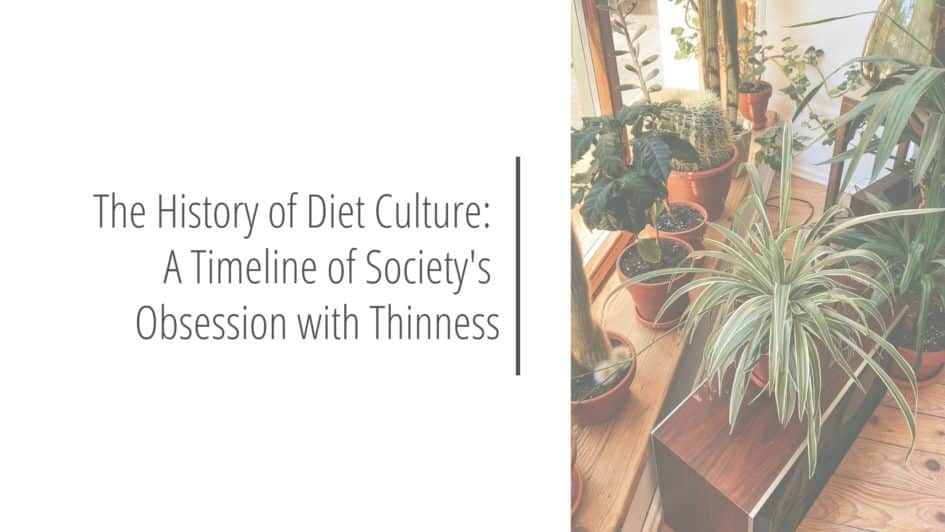Table of Contents
The Creation of Diet Culture
Diet culture didn’t appear overnight. The history of diet culture has deep roots that stretch back thousands of years. The obsession with body size, weight control, and “ideal” physiques has evolved through different eras, shaped by societal values, medical theories, and media influence.
Let’s take a journey through diet culture’s timeline to see how we got here.
Ancient Dieting: The Early Days of Food and Fasting
400 BCE: Hippocrates and the Birth of Dieting
The ancient Greek physician Hippocrates, often considered the father of modern medicine, was one of the first to suggest dietary modifications for health. He promoted moderation in eating and exercise but never advocated extreme weight loss.
Greek culture valued athleticism and physical fitness, particularly for men, as a reflection of moral and intellectual virtue. Dieting in this era was less about appearance and more about balance and vitality.
Ancient Rome: Wealth and Indulgence
In contrast to the Greeks, wealthy Romans indulged in extravagant feasts, often followed by purging to continue eating. While this wasn’t dieting in the modern sense, it reflects early societal attitudes toward controlling food intake for aesthetic or social reasons.
Excess and indulgence were symbols of wealth, yet even within this culture, moderation and control were seen as virtues among philosophers and medical practitioners.
The Middle Ages: Fasting for Purity
Medieval Religious Fasting (5th-15th Century)
During the Middle Ages, controlling food intake was often linked to religious virtue rather than aesthetics. Many religious figures practiced extreme fasting as a form of devotion. Self-denial of food was seen as a way to purify the soul and demonstrate spiritual superiority.
Gluttony was considered a sin, and fasting was a common form of penance. Women, in particular, were praised for their ability to abstain from food, with some saints achieving near-starvation levels in their quest for holiness. These practices set the stage for the later moralization of food choices and self-control.
The 19th Century: The Birth of Modern Dieting
1863: The First Diet Book
William Banting, an English undertaker, published Letter on Corpulence, Addressed to the Public, which is considered one of the first modern diet books. His low-carbohydrate approach laid the groundwork for future weight-loss movements.
Banting himself had struggled with weight gain and found that cutting out carbs helped him lose weight, making his book an early example of personalized diet testimonials influencing public perception.
Victorian Era: Corsets and Restriction
The 19th century’s beauty standards for women emphasized an extremely small waist, achieved through corsets and food restriction. The idea that body shape should be manipulated to fit societal ideals became increasingly mainstream.
Women often endured severe discomfort and even organ displacement from tightly laced corsets, which physically forced their bodies into the hourglass shape deemed desirable.
During this time, the first weight-loss drugs also emerged, some containing highly dangerous substances like arsenic and strychnine. Society began to equate thinness with refinement and self-discipline, concepts that persist in diet culture today.
The 20th Century: Dieting Becomes Big Business
1920s: The Flapper Figure
The post-war era embraced a boyish, thin frame for women, making weight loss a widespread goal. Women’s magazines began promoting diet tips to achieve the “ideal” flapper physique.
The thin look was seen as modern and progressive, in contrast to the curvier Victorian silhouette. Diet pills and weight-loss teas began to gain popularity, marking an early shift toward commercialized dieting.
1950s-60s: The Rise of Weight-Loss Companies
We can’t talk about the history of diet culture, without discussing the post-war boom that led to an increased focus on appearance. Companies like Weight Watchers (founded in 1963) turned dieting into a structured, commercial industry.
The rise of processed foods also fueled public concern over weight gain, and calorie counting became a mainstream concept.
This era also saw the introduction of amphetamines as weight-loss aids, leading to widespread addiction issues.
1970s-1980s: Low-Fat and Fad Diets Take Over
Diet culture exploded with trends like the grapefruit diet, SlimFast, and the widespread demonization of fat. The idea of “good” and “bad” foods became ingrained in the public consciousness. The low-fat craze led food manufacturers to replace fat with sugar and artificial ingredients, often making foods less nutritious.
Meanwhile, celebrities and fitness gurus like Richard Simmons and Jane Fonda promoted extreme exercise regimens and diet plans, reinforcing the idea that thinness equated to success and happiness.
The 21st Century: The Evolution of Diet Culture in Disguise
2000s: Wellness, Detoxes, and Food Moralization
As public skepticism toward traditional dieting grew, the industry rebranded itself as “wellness.” Fad diets like Atkins and South Beach were promoted as lifestyle choices rather than restrictive weight-loss programs. The rise of detox teas, juice cleanses, and superfoods fueled the idea that certain foods were inherently “clean” while others were not.
The rise of social media amplified these messages, with influencers and celebrities endorsing highly restrictive eating patterns disguised as health-conscious decisions. Phrases like “eating clean” reinforced the moralization of food, making people feel guilty for consuming anything deemed “unhealthy.”
2010s: The Rise of Anti-Diet Culture and Dieting’s Counterattack
As awareness of the harms of dieting grew, movements like Intuitive Eating and Health at Every Size (HAES) gained momentum. Books such as The Anti-Diet by Christy Harrison challenged conventional weight-loss rhetoric, emphasizing food freedom and body acceptance.
However, diet culture responded by evolving yet again. Intermittent fasting, keto, and gluten-free trends emerged, often positioned as health-driven choices rather than weight-loss programs. Yet, the underlying message remained the same: control what you eat to control your body.
Meanwhile, social media platforms became battlegrounds between anti-diet advocates and diet culture promoters.
2020s: Weight-Loss Drugs, Ozempic, and the New Era of Dieting
Despite the increasing awareness of diet culture’s harms, pharmaceutical companies have stepped in to fill the void left by traditional dieting. Weight-loss drugs like Ozempic and Wegovy have skyrocketed in popularity, offering rapid results with minimal effort. This further reinforces society’s fixation on thinness.
Meanwhile, “what I eat in a day” content, wellness influencers, and biohacking trends continue to promote food restriction in new and more technologically advanced ways. Even as body positivity movements push back, diet culture remains deeply embedded in modern life, adapting to new platforms and disguises.
Unfortunately, the history of diet culture doesn’t end here. We have many more years of fighting ahead!
Final Thoughts: Diet Culture’s Ever-Changing Face
The history of diet culture shows how deeply ingrained societal ideals about body size and food control are. While diet culture has taken many forms, it remains fundamentally the same: an industry that profits off insecurity.
Recognizing this history helps us question modern diet trends and move toward a healthier, more accepting approach to food and body image.
Thanks for reading!
Rachel Beiler, MHS, RD, LDN
References
- Banting, W. (1863). Letter on Corpulence, Addressed to the Public.
- Aphramor, L. (2010). “Validating the Bigger Picture: The Case for a Weight-Neutral Approach to Health.”
- Harrison, C. (2019). The Anti-Diet.
- Bacon, L. (2010). Health at Every Size: The Surprising Truth About Your Weight.


Leave a Reply